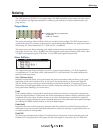
File Formats
29
Audio File Formats
The 744T records audio to industry-standard fi le formats—Windows Wave (WAV), Broadcast Wave
(BWF, monaural and polyphonic) and MPEG Layer 3 (MP3).
WAV / BWF
The 744T adheres to the AES-31 BWF fi le specifi cation. The fi lename extension is user-selectable
between .WAV or .BWF. There is no difference between the two fi le types except for the extension.
Users wishing to record “standard” wave fi les should select the .WAV extension. Time code will be
stamped at the head of the fi le, but software that does not recognize the broadcast wave data chunk
will simply ignore this added information.
The BWF fi les created by the 744T contain production information in the Broadcast Audio Extension
data chunk. Among the values recorded are:
• time code stamp
• time code frame rate
• date and time of the original recording
• bit depth
• sample rate
• originating machine serial number
All of the information contained in this chunk is available for post-production.
There are several PC and Mac utilities that will show the data from the BWF header.
MP3 – MPEG Layer 3
For music and voice recording applications where compressed audio is acceptable, the 744T can
record to industry standard MPEG Layer 3 (MP3) audio fi les. These data-compressed fi les are gener-
ated using a high-quality MP3 codec. Numerous data rates are available. When recording MP3 fi les,
the time code generator will remain running internally, but will not record time code to the fi le. The
only time reference available is the Absolute Time (A-Time) of the fi le.
The 744T can play back MP3 fi les, as well as record them. This is very useful on-set to play a person-
al MP3 audio library during downtime.
By defi nition of the fi le format, MP3 recordings are limited to two tracks, therefore only tracks A and B
are available for assignment. Time code is not a part of the MP3 format. Even with time code enabled and
running during MP3 recording, time code will not be recorded with the fi le.
Recording and Playback
Recording and playback of audio are unquestionably the most important functions of the 744T. The
user interface of the product has been designed to leverage the existing paradigm of a “tape record-
er” so that the unit is easily understood. Recording and playback functions are quite similar to that
of tape-based machines, however the nature of a non-linear recording medium provides additional
control not possible with tape-based recorders.


















